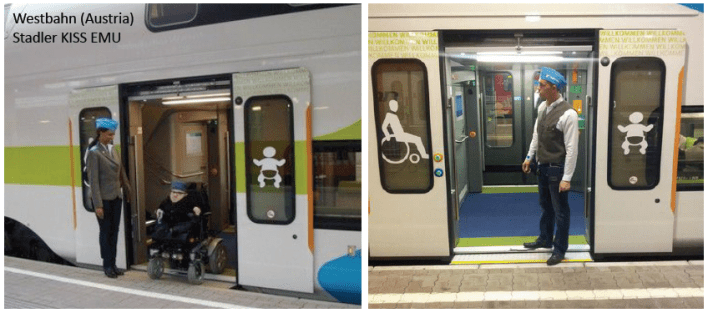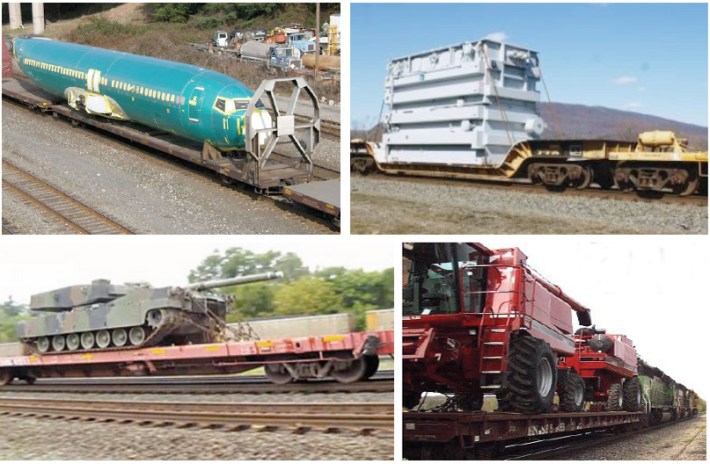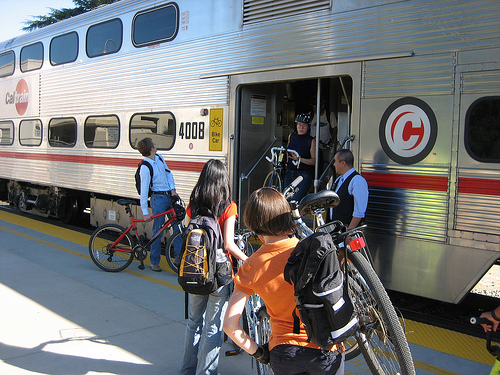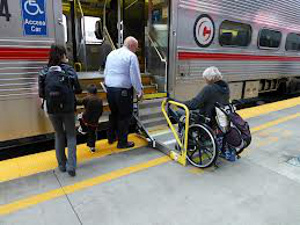As Caltrain celebrates 150 years of continuous passenger rail service between San Francisco and San Jose this year, transit planners are finally preparing to modernize the service by converting from diesel to electric trains. This transition, which Caltrain aims to complete by 2019, will reduce travel times for passengers because electric trains can accelerate and decelerate much more quickly. A typical all-stops local train trip from San Francisco would be reduced from about 90 minutes to 80 minutes.
Caltrain has long promoted electrification of the passenger rail line because electric trains are cheaper to operate and maintain -- and because faster service will attract more riders and bring in more revenue. But one very important technical detail was missing from the agency's plans until recently: Level boarding.
Currently, passengers need 55 seconds at each station, on average, to get on and off the newer two-step Bombardier train cars. The electric trains set to be purchased in 2015 will also include two steps unless the platforms at all 25 stations between San Francisco and Tamien in San Jose (the section planned to be electrified) are re-constructed 17 inches higher than they are today.
Level platforms would allow large groups and passengers with bulky items such as bicycles, strollers, suitcases, and wheelchairs to board more quickly. That would save at least 15 seconds per station, shaving an additional five minutes from the all-stops San Francisco-to-San Jose trip.

"Level boarding is just faster," said Clem Tillier, editor of the Caltrain High Speed Rail Compatibility blog. "On the basis of trip time, level boarding is at least 50 percent as effective [as electrification] and it will be far cheaper."
It would also help improve transfers between all the transit services that connect to Caltrain, including BART, Muni, SamTrans, and VTA, as well as shuttles to employers in Silicon Valley. "It makes for predictable dwell times," Tillier explained. "The transfers to other transit systems will be much more effective since you don't have to add so much padding to the schedule to make sure that you make those transfers."
Stairs are also a safety hazard, especially when getting off the train, and they create an obvious accessibility problem for the elderly and the physically challenged.
State lawmakers allocated $600 million from the California High Speed Rail project to Caltrain in July 2012, providing nearly half of the $1.5 billion cost of the Caltrain electrification project. The agency is now tasked with designing the electrification infrastructure and choosing which trains to purchase in 2015.
"That $1.5 billion program does not include money for level boarding," said Caltrain Modernization Program Executive Officer Marion Lee. "There's a lot of benefits to it, we haven't quantified any of those yet. Whatever decisions that we make about level boarding will have a link to the type of trains we purchase."
Caltrain also faces regulatory hurdles to level boarding. New passenger rail systems must include level boarding, a requirement of the Americans with Disabilities Act, but Caltrain is exempt due to older regulations governing freight rail, which still operates on its tracks. The California Public Utilities Commission General Order 26-D actually prevents level boarding from being implemented because it specifies setbacks between the platforms and freight trains in order to ensure the ability to transport large items extending over the sides of a train, such as airplanes, tanks, tractors, and other industrial equipment.

Fortunately, this type of freight isn't transported on the Caltrain tracks due to the lack of large manufacturing or agricultural facilities in San Francisco or the Peninsula. But General Order 26-D still applies to all lines that carry any freight in California. A waiver to exempt Caltrain from this requirement would need to be granted by the California Public Utilities Commission, which the rail companies (Southern Pacific and BNSF) might oppose since their priority is to maintain maximum flexibility for freight operations.
Having been lobbied for months by the advocacy group Friends of Caltrain, the agency finally stated in late September that level boarding is one of its goals for the electrification project. Funds to re-construct the platforms could be generated with a November 2016 ballot measure. Before that happens, though, the travel time benefits and construction cost would have to be accurately assessed, and the regulatory hurdles would have to be overcome.







